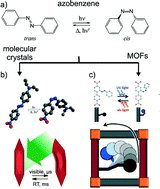Photo-induced motion of azo dyes in organized media: from single and liquid crystals, to MOFs and machines
Abstract
The field of photo-mechanical effects is a burgeoning branch of materials science dealing with the direct transformation of light energy into mechanical motion. While the research in the field has historically focused on polymeric materials, the past decades have seen the rapid emergence of crystalline, photo-mechanically active materials capable not only of converting light into mechanical motion, but also coupling such behaviour with other materials properties, e.g. microporosity in metal–organic frameworks (MOFs). This Highlight article focuses on the rapidly emerging, new area of photo-mechanical materials based on crystalline azobenzenes. The discovery of photo-mechanical motion in a needle-shaped crystal of an azobenzene led to an explosion of research and new developments in less than 5 years, revealing new types of photo-mechanical behaviour, crystal engineering routes to easily create libraries of crystalline photo-mechanical materials, in situ and real-time studies of structural changes during photo-mechanical effect using X-ray diffraction, and the discovery of new supramolecular interactions enabling the engineering of photo-mechanical azobenzene crystals in terms of molecular stacking, as well as crystal morphology.

- This article is part of the themed collection: Solid-State Photochemistry

 Please wait while we load your content...
Please wait while we load your content...